Do you want to generate ideas for SEO tests to prove positive ROI and improve your bottom line?
SEO testing is the discipline of evaluating and, crucially, validating SEO theories and experiments. In this article, we explore the concept and how you can come up with ideas to test, helping you generate positive, measurable, and quantifiable ROI with SEO.
1. What Is SEO Testing?
Put simply, SEO testing allows you to work out whether an SEO activity is net beneficial or not.
Many SEO activities are conducted without a measure of their performance. This is further complicated by the fact that nothing is static, and response times can be long. It’s important to isolate and measure the response if you are going to be able to effectively evaluate an SEO activity.
As a practice, SEO testing is often confused with AB Testing or split testing. AB Testing is more of a user experience (UX) and website experience test that usually focuses on Conversion Rate Optimization (CRO).
For example, if the ‘buy now’ button is changed to red instead of blue, will conversions go up?
This is a valuable exercise and has its worth, but it does not measure the effect of organic traffic heading to your site. It only measures the behavior of traffic once it has arrived at your site.
SEO testing, sometimes also referred to as SEO cohort testing, looks at the effect on organic rankings and traffic to pages based on a change. This is nuanced, but distinct from testing the effect of how traffic behaves once it’s hit your target pages.
It can be much more powerful, as it can help tailor an SEO strategy and allow you to focus on efforts that are materially impactful to your ROI, rather than just saying, “yes, overall, our SEO campaign increased traffic by X% over Y months.”
In SEO testing, you can typically influence three main areas:
- Search Appearance
- Technical
- Content
1.1 Search Appearance
‘Search appearance’ refers to anything that affects how your site will be displayed in search engine results pages (SERPs), including:
- Meta titles
- Meta descriptions
- SERP features, such as Featured Snippets
In SEO, we talk about “owning the SERP,” which means getting as much real estate and visibility on a SERP as possible.
Understanding which SERP features are on display for the terms you are targeting and how they are varying is vital to understanding how your site appears in the SERPs. This can, to an extent, dictate part of your SEO strategy.
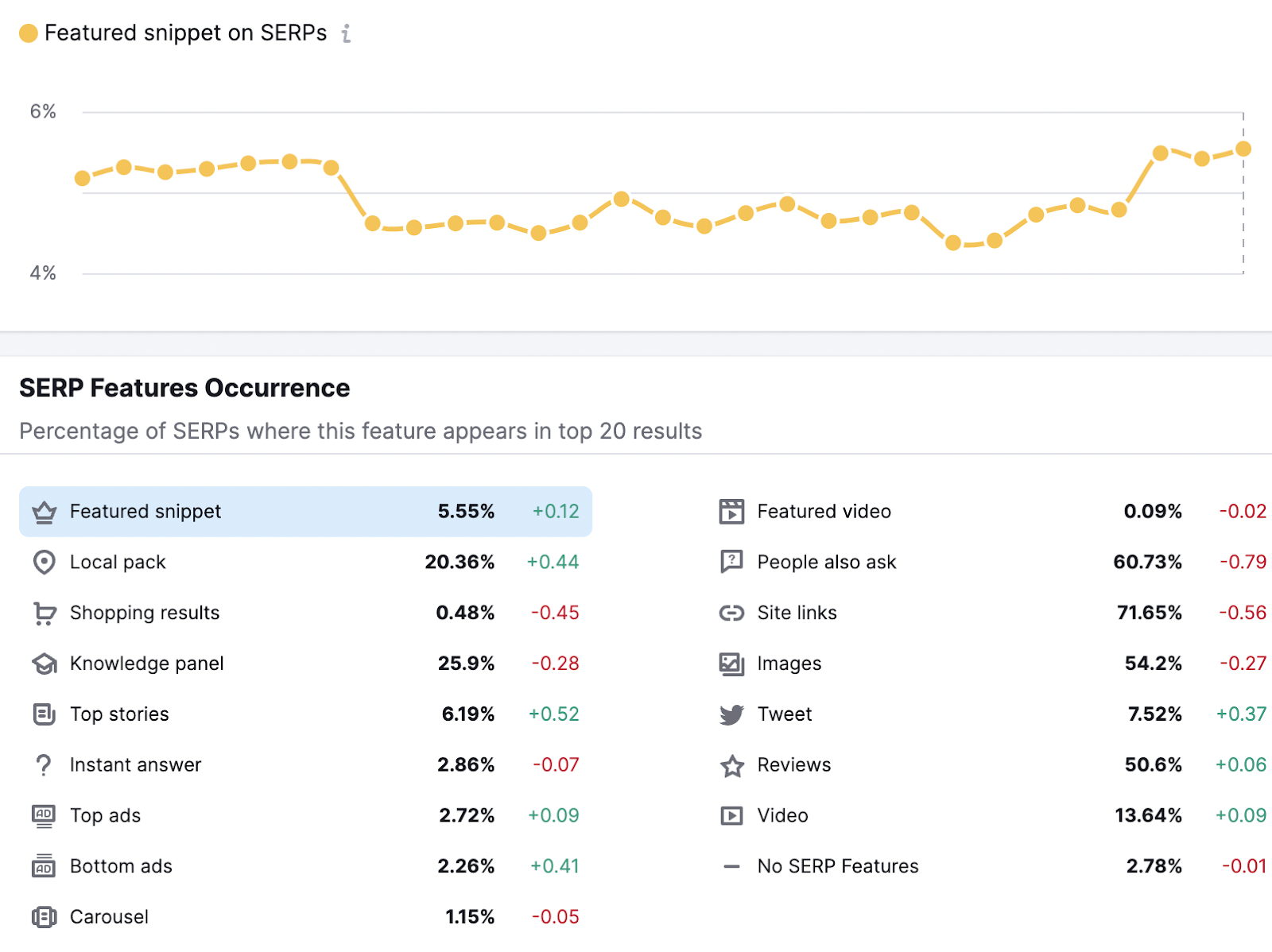
Data from Semrush Sensor
1.2 Technical
With Technical SEO, there are many significant influencing factors. They are usually compounded by many other dynamic factors, but, with SEO testing, you can isolate the effect of any particular action (more to come on what can be tested in section two).
If you want to know how impactful adding a certain type of schema to your site will be, for example, you can test this specifically with a control case and evaluate the change.
Merely adding it and hoping it has an impact without measurement has much less value, especially when you need to apply significant resources to scale it across thousands of pages.
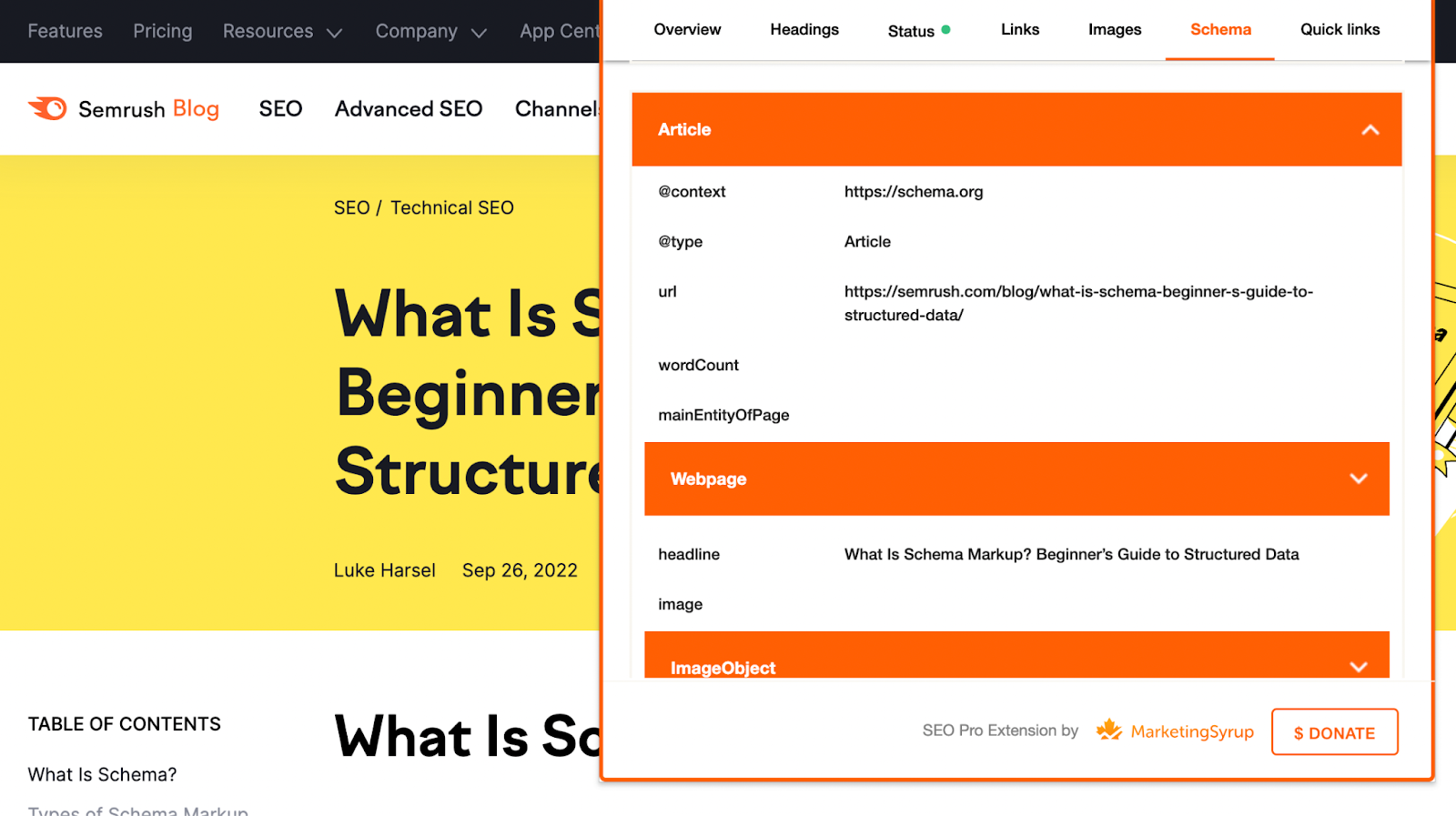
1.3 Content
One of the more measurable areas on a site is content. If you want to know how valuable content is, you can start adding or removing specific sections and testing to quantify the ROI. Here’s a great real-world example of the effect of removing quality content.
When it comes to crafting a high-quality website, content can prove to be one of the most significant investments—and often rightly so. Google’s John Mueller spoke about how it is hard to call a site an authority with only 30 articles on a topic:
“It’s really hard to call a site authoritative after 30 articles, and especially if you’ve stopped publishing for a while, I can see how Google might be a bit more conservative with regards to indexing more.”
John Mueller, Google Search Liason
2. SEO Testing Ideas
Now, let’s delve into some specific areas you can focus on for SEO testing so you can start experimenting for yourself.
Feel free to jump to a specific section—they’re organized as follows:
2.1 Check Your Competitors’ Sites
2.2 Settle Internal Debates
2.3 Quantify ROI with SEO Testing
2.4 Validate the Advice Your SEO Agency is Giving You
2.5 Validate Google's Recommendations
2.6 Validate “Best Practices”
2.7 Check Your Dev Queue
2.8 Reduction Technique
2.1 Check Your Competitors’ Sites
Let’s say your competitor is doing something different than you, and you want to find out if something similar will work for your site. Make a list of things you want to test and get started to find out. Here are some options.
Do Numbers in Title Tags Affect CTR?
The use of numbers in headings is often debated, so it’s unsurprisingly a well-tested area. You can read about a recent SplitSignal test on how numbers in title tags affect CTR here.
Think about how, where, and why numbers might be useful in your title tags.
What is the search intent? What is someone searching for when they are looking for your product? Take a look in Google Search Console (GSC) for where product-specific numbers occur, and see if there are any queries that contain numbers.
Could you potentially provide more useful information and context by adding some numbers to your title tags?
Does Adding Emojis to Your Titles Work?
Some marketers swear by the use of emojis. They can work in certain circumstances—here’s an example of a SplitSignal test that shows a positive effect from the use of emojis.
Say your CEO is sold on them, but your brand team won’t sign off on the idea. The perfect opportunity to put it to the test!
What types of emojis or symbols could help accentuate your brand, emphasize your offering, or draw attention to your result in the SERP?

It could pay to get creative with emojis and test for any positive results—you might surprise a few people.
Dates and Times
What about adding the word [Updated] and changing the year in your titles? Does that help or hinder performance?
Sometimes, adding the year to a title can make your content much more aligned with the search intent of some users. However, there are situations where having the year in the title can hurt you, especially when the content itself is not updated or has become stale.
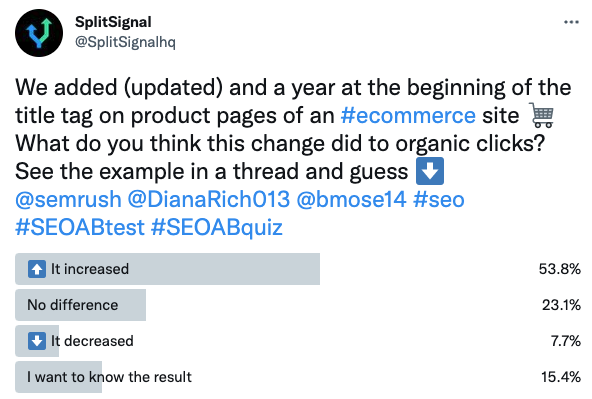
Query Deserves Freshness / Activity / Freshness
The term query deserves freshness (QDF) has been around for a while. It refers to the fact that some types of content, some pages, and some searches necessitate more up-to-date content than others.
Here, you might perform a controlled test with a set of updated pages versus a set of old pages that haven’t been updated, and see how performance is affected.
Does fresh content help in your niche? Do your target queries deserve freshness, or will more evergreen content do the trick?
If you only update the ‘published on’ or last updated date, will it boost your SEO? Why not plan an experiment to find out?
2.2 Settle Internal Debates
If there are certain things you can’t agree on internally, from minor technical changes to time-intensive content creation, you can put the debate to bed with SplitSignal.
Schema
Schema markup can be very expansive, and it’s often relatively straightforward to apply site-wide, but it’s much more challenging to populate with useful data. Before you have a whole team go to town with the schema, you can test the value of it.
Here’s Google’s stance on schema:
“Google Search works hard to understand the content of a page. You can help us by providing explicit clues about the meaning of a page to Google by including structured data on the page.”
Sounds like it can play a pretty important role, right? Put your own schema markup to the test and see how much it’s helping you.
Take a look at a recent SplitSignal test on removing FAQ schema here to see what effect it might have on your site.
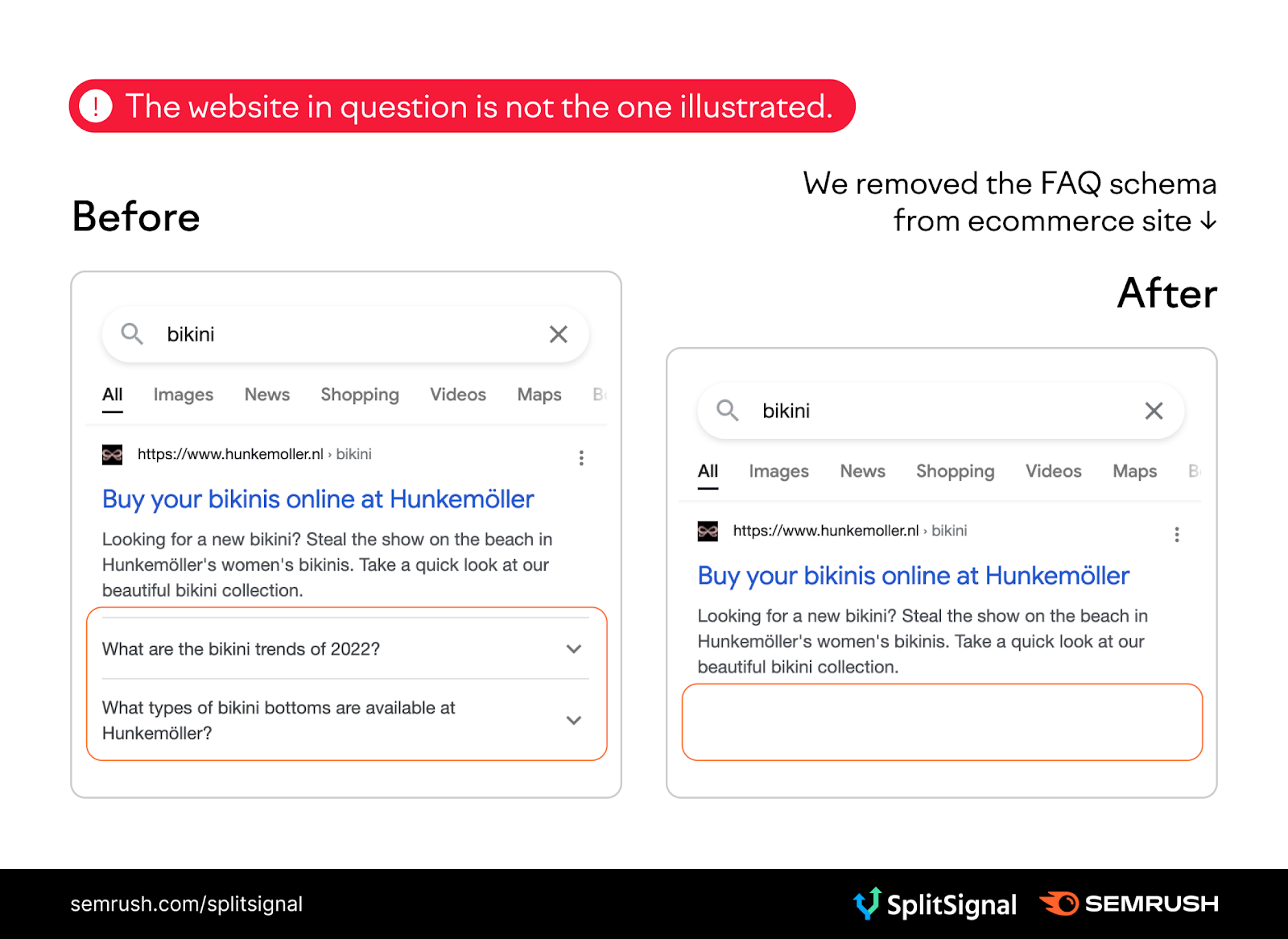
Core Web Vitals (CWV)
Google’s CWV, part of its wider page experience algorithm, was one of the most debated and active areas of SEO in 2021. It ultimately didn’t have the impact that some thought, but for the first time, Google basically stated the page speed, and loading performance was, at least in some part, a ranking factor.
So, what can you test that affects CWV and may impact organic rankings? Is that large image really the reason the page doesn’t rank well? Does minifying all of your CSS and JavaScript really do anything? Are plugins really helping or hurting your SEO?
Appearance
You might want to test different themes on your site. Changing page-level CSS can have a dramatic effect on page performance.
The scope of style and design changes is almost limitless, but you can evaluate what works for your site and what doesn’t over time. It has been observed many times that a redesign or reskin can have a material impact on rankings, likely due to the behavior and interaction of the traffic that arrives on your site. The exact reasons may not be obvious, but the results might speak for themselves.
Removing Comments
User Generated Content (UGC) like comments can be quite useful in some areas, but harmful in others, especially if there is a significant volume of low-quality, spammy comments.
It may take a lot of resources to moderate comments, leaving you wondering if it’s worth it, so it’s a great area to put to the test.
Videos
There are many ways to include video on a site. Some of them may have technical limitations, while others may have benefits when it comes to user engagement.
You might look at whether or not videos in iframes are doing anything for you. If not, will you be better off uploading them yourself? Does adding schema and other structured data around video help? Put it to the test to find out.
Meta Descriptions
You have a couple of choices when it comes to meta descriptions, too. Are you better off letting Google determine them for you, or should you invest the time to write them yourself for each individual page?

Title Structure
The structure of your title is often based on a template, but does the order or type of elements used in the title matter? Can organic performance be improved by tweaking where you place your brand name or the description of the page’s content?
Images
You might take a look at your images as part of your SEO testing as well.
Do you really need those big hero images? They might look great, but pushing content below the fold might mean some early messaging is lost on a portion of your visitors. Take the time to determine the best use of images for your audience.
2.3 Quantify ROI with SEO Testing
It’s certainly not an easy job to quantify ROI in SEO, but this is where testing comes into its own. A robust SEO split test is one way to help you obtain solid, quantifiable data to inform your strategy.
It’s not limited to one particular area, of course, but you might want to focus first on those that take up the most resource so you can be sure it’s being put to good use.
A title tag tweak, for instance, is unlikely to have a major effect on ROI, but evaluating a whole content section of your site quite possibly will. Break down your task list and SEO activities into a table and work out how much you spend on each activity, taking a top-down approach and looking at the big hitters first.
2.4 Validate the Advice Your SEO Agency is Giving You
Investment in SEO can be significant and the payback is often quite far down the road, but it can offer the best ROI of any digital marketing channel. That sometimes doesn’t make the initial outlay any easier to stomach, though.
Let’s say you’re getting conflicting advice from two different team members about how to optimize that new section of your site. You can put it to the test with SplitSignal and work out what value you are getting or might get from SEO.
Making the Most of H Tags
It is not uncommon to see multiple H1 tags on a page. It is common to see this as a subject of much debate.
A common issue is when both keyword-specific headings and brand-specific headings are marked up with H1 tags on the same page. Some studies have shown that this is not an issue, but others have demonstrated the negative effect of changing the styling on an H1 tag.
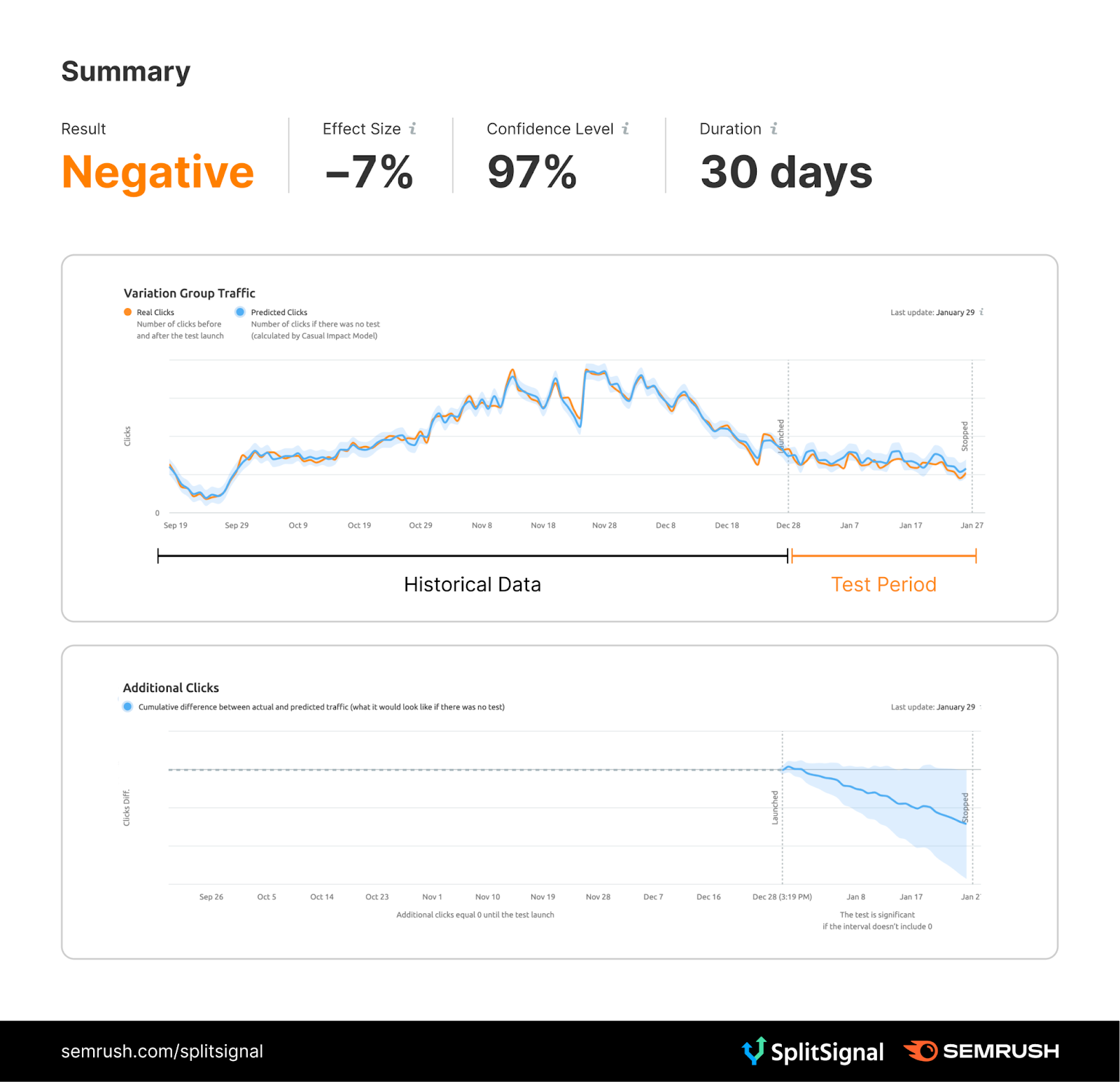
The fact of the matter is that every site and sometimes every page can have different requirements, so it’s important to put things like H tags to the test, too.
Reviews and Star Ratings
Review schema markup is a common recommendation in SEO—it gives you a chance to feature star ratings alongside your descriptions in the SERPs.
Will their presence increase CTR and bring you more traffic? Will star ratings boost your site-wide product sales, or only in certain categories?
2.5 Validate Google’s Recommendations
John Mueller often provides the SEO community with helpful feedback regarding how to manage websites for the best. The challenge, though, is that he can only give broad, generic advice that doesn’t apply to specific types of sites. Every site and every niche is different, so what works for one might not work for others.
We see time and time again that large-scale SEO tests come out with results that are proven wrong in certain situations. While generalizations and trends are useful, the value really comes in when you can be very specific and test what counts for your site in your niche.
What Google says and what Google does are not necessarily the same thing, so be sure to put recommendations to the test whenever you can.
Changing Publishing Dates
One example of a good reason to test is Google’s strong suggestion that changing the dates and times on your pages won’t affect rankings. Since John Mueller’s quote in April 2021, many people have argued to the contrary after they’ve put it to the test:
“I don’t think it would change anything with regards to search, and we definitely wouldn’t rank those pages differently in search just because you’re changing the date and time on a page.”
Google’s John Mueller
2.6 Validate “Best Practices”
The fact that something is considered best practice doesn’t mean it will work for every website.
Sometimes, strongly-held best practices cease to be so in SEO, but they can linger in the community nonetheless.
A classic example of this was the rel=next recommendation for paginated URLs—Google quietly stopped using them a few years ago and nobody noticed! The lesson? You can only really know what works if you are testing it out for yourself
Heading Tags
Heading tags have long been considered an SEO mainstay and one of the most important on-page SEO elements around. There are often debates about the use of multiple H1 tags, whether an H1 should be an H1 or an H2, and whether the main marketing message should be in a heading tag or not. Some tests have actually shown that removing H1 tags and replacing them with H2 tags or even P tags makes no difference.
H3 Tags on Product Names
Despite some tests showing that heading tags don’t matter much, there are some situations in which they most definitely do. This SplitSignal test looked at adding an H3 heading to product names on ecommerce category pages:
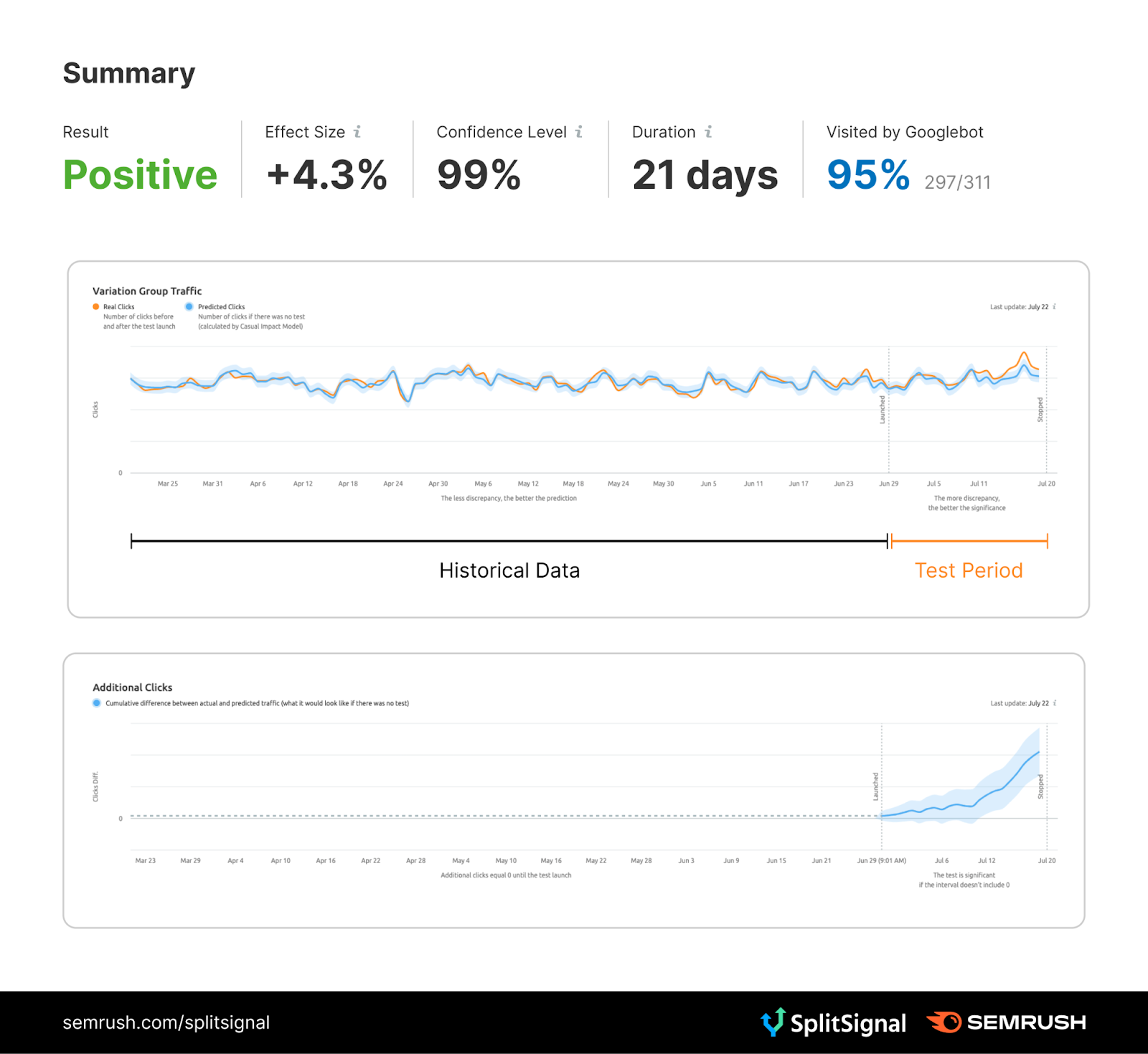
As you can see, the result of this test was quite significantly positive.
Be sure to test different markups and styling of key elements on your pages and use the insights to inform your strategy.
2.7 Check Your Dev Queue
The bandwidth and effectiveness of your dev team can have an effect on your SEO-driven revenue.
If you want to make sure you are getting the most out of your dev team’s efforts, you need to test what they are doing and what they are planning. When used in this way, SplitSignal has the potential to significantly impact your revenue and ROI in a positive way.
What Is in Your Dev Queue?
Look at the tasks that you have for your dev team.
Have a critical look at what the theory is behind the effort and the hypothesis for making the change. Distill it down to its constituent parts and reduce it to elements that can be tested.
Evaluate whether or not the reward is worth the effort, or show that it will actually have a net negative effect that you definitely don’t want to scale.
What Is Your Team Planning?
Do you have some major plans for change to your site? Are you looking at making a major structural change, or adding a new type of navigation menu?
Break it down and test it first—this will let you know if it is worth investing the time.
Which Activities Do You Spend the Most on?
Look back at your activities and categorize them by investment and time spent, breaking them down into individual activities. Can you separate these out into elements that can be put to the test?
Let’s say you allocate 50% of your team’s time to technical SEO activities, but find through testing that this only has a very minimal impact on performance. This might be an indication that you need to take another look at your strategy, and/or reallocate some resources to tasks that might be more impactful.
2.8 The Reduction Technique
With SplitSignal, you can evaluate how beneficial certain sections of your site are by removing them and testing the results.
If it turns out you can remove a section of your site, such as a blog, without seeing much of a response, it’s probably not providing much value. This might suggest that you should not be committing resources to it.
Similarly, if you see a large negative effect by removing a certain section, it’s a sign that it’s working and that you should commit more resources to it.
It’s a worthwhile technique because it requires no developer time, it’s not technical work, and no new content needs to be produced. It quickly tells you what the most impactful areas of your site are instead, and allows you to prioritize accordingly.
You might remove content elements, navigation elements, or broad and bloaty navigation cues on deep-level specific categories. Whatever you do, make sure it’s backed up by real data from a split test with SplitSignal.
Time to Get Testing
SEO testing is your route to a more informed, data-led strategy that will not only boost your confidence in your approach but also enhance the legitimacy of the calls you make along the way.
Here, we’ve been through a number of tests you can run to improve your performance in everything from how you appear in the SERPs to how you structure your headers. SplitSignal gives you absolute freedom to put everything to the test, so you’ll always know what to do and what not to do when it comes to proving ROI with your SEO.
It’s time to start on those experiments!
